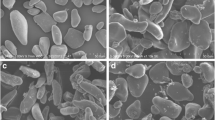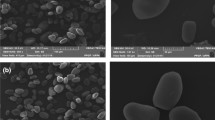Abstract
Determination of the characteristics of native starches is crucial in order to select their best application in various industrial fields. Thus, two different types of non-traditional native starches from the Dioscoreaceas species (Dioscorea sp. and Dioscorea piperifolia Humb. var. Wild) were studied regarding their thermal, structural and rheological properties. The results were contrasted with traditional commercial starch sources (potato, cassava and corn). From the thermogravimetric results (TG/DTG), D. piperifolia starch obtained the highest thermal stability of the samples, except for potato starch. Furthermore, using differential scanning calorimetry and viscoamylograph profiles (RVA), it was found that the Dioscoreaceas starches presented a higher onset (T o) temperature and susceptibility to retrogradation. They also showed lower values in relation to relative crystallinity, which was calculated from their X-ray patterns and tendency to white (L*) colour. The shapes of the Discoreaceas starch granules were determined using electron microscopy; it was found that as the potato starch the Dioscoreaceas starches showed a wide range of particle size.






Similar content being viewed by others
References
Hornung PS, Oliveira CS, Lazzaroto M, Lazzarotto SRS, Schnitzler E. Investigation of the proto-oxidation of cassava starch granules. J Therm Anal Calorim. 2015;123:2129–37.
Oliveira CS, Andrade MMP, Colman TAD, Costa FJOG, Schnitzler E. Thermal, structural and rheological behavior of native and modified waxy corn starch with hydrochloric acid at different tempertures. J Therm Anal Calorim. 2014;115:13–8.
Huang J, Zhao L, Man J, Wang J, Zhou W, Huai H, Wei C. Comparison of physicochemical properties of B-type nontraditional starches from different sources. Int J Biol Macromol. 2015;78:165–72.
Leonel M, Cereda MP. Caracterização físico-química de algumas tuberosas amiláceas. Ciênc Tecnol Aliment. 2002;22:65–9.
Nascimento WF, Siqueira MVBM, Ferreira AB, Ming LC, Peroni N, Veasey EA. Distribution, management and diversity of the endangered Ameridian yam (Dioscorea trifida L.). Braz J Biol. 2015;75:104–13.
Okunlola A, Odeku OA. Evaluation of starches obtained from four Dioscorea species as biding agent in chloroquine phosphate tablet formulations. Saudi Pharm J. 2011;19:95–105.
Jiang Q, Gao W, Xia L, Xia Y, Wang H, Wu S, Huang L, Liu C, Xiao P. Characterizations of starches isolated from five different Dioscorea L. species. Food Hydrocoll. 2012;29:35–41.
Jiang Q, Gao W, Shi Y, Xia L, Wang W, Huang L, Xiao P. Physicochemical properties and in vitro digestion of starches from different Dioscorea plants. Food Hydrocoll. 2013;32:432–9.
Falade KO, Ayetigbo OE. Effects of annealing, acid hydrolysis and citric acid modifications on physical and functional properties of starches from four yam (Dioscorea spp.) cultivars. Food Hydrocoll. 2015;43:529–39.
Bicudo SCW, Demiate IM, Bannach G, Lacerda LG, Carvalho-Filho MAS, Ionashiro M, Schnitzler E. Thermoanalytical study and characterization of native starches of Paraná pine seeds (Araucaria angustifolia, Bert O. Ktze) and European chestnut seeds (Castanea sativa Mill). Eclet Quim. 2009;34:7–12.
Sangseethong K, Termvejsayanon N, Sriroth K. Characterization of physicochemical properties of hypochlorite and peroxide-oxidized cassava starches. Carbohydr Polym. 2010;82:446–53.
Lacerda LG, Colman TAD, Baub T, Carvalho MAS, Demiate IM, Vasconcelos EC, Schnitzler E. Thermal, structural and rheological properties of starch from avocado seeds (Persea americana, Miller) modified with standard hypochlorite sodium. J Therm Anal Calorim. 2014;115:1893–9.
Cordoba LP, Ribeiro LS, Colman TAD, Oliveira CS, Andrade MMP, Costa FJOG, Schnitzler E. Effect of hydrochloric acid in different concentrations and temperatures up to some properties of organic cassava starch. Braz J Therm Anal. 2013;2:6–11.
Colman TAD, Demiate IM, Schnitzler E. The effect of microwave radiation on some thermal, rheological and structural properties of cassava starch. J Therm Anal Calorim. 2014;115:2245–52.
Andrade MMP, Oliveira CS, Colman TAD, Costa FJOG, Schnitzler E. Effects of heat-moisture treatment on organic cassava starch. J Therm Anal Calorim. 2014;115:2115–22.
Granza AG, Travalini AP, Farias FO, Colman TAD, Schnitzler S, Demiate IM. Effects of acetylation and acetylation–hydropropylation (dual-modification) on the properties of starch from Carioca bean (Phaseolus vulgaris L.). J Therm Anal Calorim. 2014;119:769–77.
Beninca C, Colman TAD, Lacerda LG, Carvalho-Filho MAS, Demiate IM, Schnitzler E. Thermal, rheological, and structural behaviors of natural and modified cassava starch granules, with hypochlorite solutions. J Therm Anal Calorim. 2013;111:2217–22.
Zhang L, Xie W, Zhao X, Liu Y, Gao W. Study on the morphology, crystalline structure and thermal properties of yellow ginger starch acetates with different degrees of substitution. Thermochim Acta. 2009;495:57–62.
Alberton C, Colman TAD, Souza JA, Oliveira CS, Andrade PMM, Schnitzler E. Thermal analysis, rheology, X-ray diffractometry and Atomic Force microscopy in the evaluation of binary mixtures of “starches hydrocolloids”. J Microbiol Biotechnol Food Sci. 2014;3:305–9.
Hornung PS, Granza AG, Oliveira CS, Lazzaroto M, Schnitzler E. Study of the effects of ultraviolet light and sodium hypochlorite solutions on properties of cassava starch granules. Food Biophys. 2015;10:368–74.
Adamovicz JAL, Cordoba LP, Ribeiro LS, Schnitzler E, Oliveira CS. Evaluation on thermal, rheological and structural properties on the mixture of potato starch and pectin. Carpath J Food Sci Technol. 2015;7:45–52.
Lacerda LG, Filho MASC, Demiate IM, Bannach G, Ionashiro M, Schnitzler E. Thermal behaviour of corn starch granules under action of fungal a-amylase. J Therm Anal Calorim. 2008;93:445–9.
Jayakody L, Hoover R, Liu Q, Donner E. Studies on tuber starches. II. Molecular structure, composition and physicochemical properties of yam (Dioscorea sp.) starches grown in Sri Lanka. Carbohydr Polym. 2007;69:148–63.
Cooke D, Gidley MJ. Loss of crystalline and molecular order during starch gelatinization: origin of the enthalpic transition. Carbohydr Res. 1992;227:103–12.
N’da Kouamé V, Handschin S, Derungs M, Amani G, Conde-Petit B. Thermal properties of new varieties of yam starches. Starch Stärke. 2011;63:747–53.
Costa FJOG, Leivas CL, Waszczynsky N, Godoi RCB, Helm CV, Colman TAD, Schnitzler E. Characterization of native starches of seeds of Araucaria angustifolia from four germplasm collection. Thermochim Acta. 2013;565:172–7.
Aggarwal P, Dollimore DA. Thermal analysis investigation of partially hydrolyzed starch. Thermochim Acta. 1998;319:17–25.
Kenshun L, Rosentrater KA. Distillers grains: production, properties and utilization. 1st ed. Dublin: AOCS Press; 2016.
Pérez E, Gibert O, Rolland-Sabaté A, Segovia X, Sánchez T, Reynes M, Dufour D. Evaluation of the functional properties of promising Dioscorea trifida L. waxy starches for food innovation. Int. J Carbohydr Chem. 2011;2011:1–7.
Xia L, Wenyuan G, Qianqian J, Yanli W, Xinhua G, Luqi H. Physicochemical, crystalline, and thermal properties of native, oxidized, acid, and enzyme hydrolyzed Chinese yam (Dioscorea opposite Thunb) starch. Starch Stärke. 2011;63:616–24.
Pérez E, Rolland-Sabaté A, Dufour D, Guzman R, Tapia M, Raymundez M, Ricci J, Guilois S, Pontoire B, Reynes M, Gibert O. Isolated starches from yams (Dioscorea sp.) grown at the Venezuelan Amazons: structure and functional properties. Carbohydr Polym. 2013;98:650–8.
Campbell MR, Li J, Berke TG, Glover DV. Variation of starch granule size in tropical maize germ plasm. Cereal Chem. 1996;75:536–8.
Zhou Q, Shi W, Meng X, Liu Y. Studies on the morphological, crystalline, thermal properties of an underutilized starch from yam Dioscoreae zingiberensis CH Wright. Starch Stärke. 2013;65:123–33.
Wongsagonsup R, Pujchakarn T, Jitrakbumrung S, Chaiwat W, Fuongfuchat A, Varavinit S, Dangtip S, Suphantharika M. Effect of cross-linking on physicochemical properties of tapioca starch and its application in soup product. Carbohydr Polym. 2014;101:656–65.
Tovar J, Melito C, Herrera E, Rascón A, Pérez E. Resistant starch formation does not parallel syneresis tendency in different starch gels. Food Chem. 2002;76:455–9.
Aalcázar-Alay SC, Meireles MAA. Physicochemical properties, modifications and applications of starches from different botanical sources. Food Sci Technol. 2015;35:215–36.
Simková D, Lachman J, Hamouz K, Vokál B. Effect of cultivar, location and year on total starch, amylose, phosphorus content and starch grain size of high starch potato cultivars for food and industrial processing. Food Chem. 2013;141:3872–80.
Koksel H, Masatcioglu T, Kahraman K, Ozturk S, Basman A. Improving effect of lyophilization on functional properties of resistant starch preparations formed by acid hydrolysis and heat treatment. J Cereal Sci. 2008;47:275–82.
Riley CK, Adebayo SA, Wheatley AO, Asemota HN. Surface properties of yam (Dioscorea sp.) starch powders and potential for use as binders and disintegrants in drug formulations. Powder Technol. 2008;3:280–5.
Mali S, Grossmann MVE, Yamachita F. Filmes de amido: Produção, propriedades e potencial de utilização. Semin Ciênc Agrár. 2010;31:137–56.
Lin L, Cai C, Gilbert RG, Li E, Wang J, Wei C. Relationships between amylopectin molecular structures and functional properties of different-sized fractions of normal and high-amylose maize starches. Food Hydrocoll. 2016;52:359–68.
Oli P, Ward R, Adhikari B, Torley P. Colour change in rice during hydration: effect of hull and bran layers. J Food Eng. 2016;173:49–58.
Chung H-J, Chang H-I, Lim S-T. Physical aging of glassy normal and waxy rice starches: effect of crystallinity on glass transition and enthalpy relaxation. Carbohydr Polym. 2004;58:101–7.
Rodrigues LL, Sousa MMD, Silva JN, Marques MJ, Brito P, Lima A. Caracterização físico-química e detecção de metabólitos secundários do cará molea (Dioscorea bulbífera). VII Connepi. 2012;7:1–6.
Falade KO, Christopher AS. Physical, functional, pasting and thermal properties of flours and starches of six Nigerian rice cultivars. Food Hydrocoll. 2015;44:479–90.
Acknowledgements
The authors gratefully acknowledge CAPES,Brazil, for the financial resources provided and to C-LABMU—UEPG for the performed instrumental analysis.
Author information
Authors and Affiliations
Corresponding author
Rights and permissions
About this article
Cite this article
Hornung, P.S., do Prado Cordoba, L., da Silveira Lazzarotto, S.R. et al. Brazilian Dioscoreaceas starches. J Therm Anal Calorim 127, 1869–1877 (2017). https://doi.org/10.1007/s10973-016-5747-5
Received:
Accepted:
Published:
Issue Date:
DOI: https://doi.org/10.1007/s10973-016-5747-5




